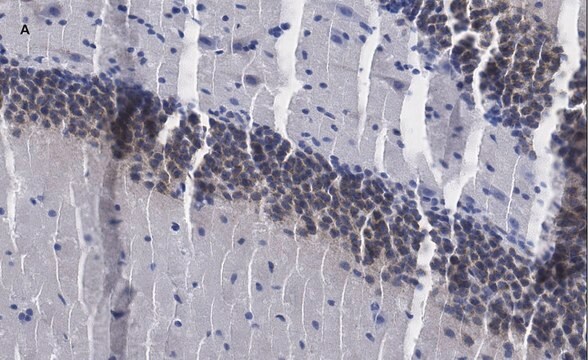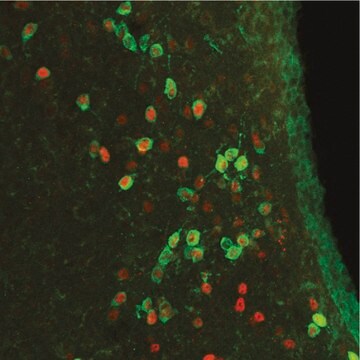PC05L
Anti-c-Fos (Ab-2) (4-17) Rabbit pAb
lyophilized, Calbiochem®
Sign Into View Organizational & Contract Pricing
All Photos(1)
About This Item
UNSPSC Code:
12352203
Recommended Products
biological source
rabbit
Quality Level
antibody form
affinity isolated antibody
antibody product type
primary antibodies
clone
polyclonal
form
lyophilized
does not contain
preservative
species reactivity
rat, human, mouse
manufacturer/tradename
Calbiochem®
storage condition
OK to freeze
isotype
IgG
shipped in
ambient
storage temp.
2-8°C
target post-translational modification
unmodified
Gene Information
human ... FOS(2353)
General description
Immunoaffinity purified rabbit polyclonal antibody. Recognizes the ~50-62 kDa c-Fos protein.
Recognizes the ~50-62 kDa c-Fos protein in HepG2, NIH3T3, and MCF-7 cells.
The proto-oncogene fos has been implicated in cell growth, differentiation and development. fos is induced by a large number of stimuli including mitogens, differentiation-specific agents, pharmacological agents, etc. Induction of the 62,000 dalton fos protein is rapid but transient. The fos protein is associated with a 39,000 dalton protein which has been identified as the protein product of the jun proto-oncogene (c-jun). The fos/jun protein complex binds specifically to a sequence element in DNA referred to as the AP-1 binding site.
This Anti-c-Fos (Ab-2) (4-17) Rabbit pAb is validated for use in Frozen Sections, WB, IF, IP, Paraffin Sections, Gel Shift, for the detection of c-Fos (Ab-2) (4-17).
Immunogen
Human
a synthetic peptide (SGFNADYEASSSRC) (Cat. No. PP10) corresponding to amino acids 4-17 of human c-Fos
Application
Frozen Sections (5-10 µg/ml)
Immunoblotting (1-5 µg/ml)
Immunofluorescence (1-5 µg/ml)
Immunoprecipitation (1-2 µg per reaction)
Paraffin Sections (5-10 µg/ml, heat or pepsin pre-treatment required)
Gel Shift (see comments and application references)
Free-floating Sections (not recommended)
Immunoblotting (1-5 µg/ml)
Immunofluorescence (1-5 µg/ml)
Immunoprecipitation (1-2 µg per reaction)
Paraffin Sections (5-10 µg/ml, heat or pepsin pre-treatment required)
Gel Shift (see comments and application references)
Free-floating Sections (not recommended)
Warning
Toxicity: Standard Handling (A)
Physical form
Lyophilized from PBS, a volatile buffer, 100 µg BSA.
Reconstitution
Resuspend the lyophilized antibody with sterile phosphate buffered saline (PBS), pH 7.4, or sterile 20 mM Tris-saline (20 mM Tris containing 0.15 M NaCl), pH 7.4, to yield a final concentration of 100 µg/ml; product will be more stable if 0.1% sodium azide is included (do not add azide if antibody is to be used with viable cells). Lyophilized antibodies should be resuspended at 4°C with occasional gentle mixing.
Analysis Note
Positive Control
Hep G2 or NIH 3T3 cells
Hep G2 or NIH 3T3 cells
Other Notes
DeTogni, P., et al. 1988. Cell Biol.8, 2251.
Rouscher III, F.J., et al. 1988. Science240, 1010.
Sassone-Corsi, P., et al. 1988. Cell54, 553.
Verma, I.M. and Graham, W.R. 1987. Cancer Res.49, 29.
Verma, I.M. and Sassone-Corsi, P. 1987. Cell51, 513.
Muller, R. 1986. Biochim. Biophys. Acta823, 207.
Verma, I. 1986. Trends Genet.2, 93.
Greenberg, M. and Ziff, E. 1984. Nature (London), 311, 433
Rouscher III, F.J., et al. 1988. Science240, 1010.
Sassone-Corsi, P., et al. 1988. Cell54, 553.
Verma, I.M. and Graham, W.R. 1987. Cancer Res.49, 29.
Verma, I.M. and Sassone-Corsi, P. 1987. Cell51, 513.
Muller, R. 1986. Biochim. Biophys. Acta823, 207.
Verma, I. 1986. Trends Genet.2, 93.
Greenberg, M. and Ziff, E. 1984. Nature (London), 311, 433
For gel shift assays resuspend in 100 µl of buffer. The immunogen, c-fos (Peptide-2), Cat. No. PP10, is also available for competition studies (see Murphy, et al. below). Antibodies should be titrated for optimal results in individual systems.
Legal Information
CALBIOCHEM is a registered trademark of Merck KGaA, Darmstadt, Germany
Not finding the right product?
Try our Product Selector Tool.
Storage Class Code
12 - Non Combustible Liquids
WGK
nwg
Flash Point(F)
Not applicable
Flash Point(C)
Not applicable
Certificates of Analysis (COA)
Search for Certificates of Analysis (COA) by entering the products Lot/Batch Number. Lot and Batch Numbers can be found on a product’s label following the words ‘Lot’ or ‘Batch’.
Already Own This Product?
Find documentation for the products that you have recently purchased in the Document Library.
M E Greenberg et al.
Nature, 311(5985), 433-438 (1984-10-04)
Transcription of the c-fos proto-oncogene is greatly increased within minutes of administering purified growth factors to quiescent 3T3 cells. This stimulation is the most rapid transcriptional response to peptide growth factors yet described, and implies a role for c-fos in
P Sassone-Corsi et al.
Cell, 54(4), 553-560 (1988-08-12)
Proto-oncogene fos encodes a nuclear protein that appears to be involved in the transcriptional regulation of some genes. fos protein (p55fos) is associated with other nuclear proteins in complexes that bind to regulatory regions containing TPA-responsive promoter elements (TREs). The
The fos oncogene.
I M Verma et al.
Advances in cancer research, 49, 29-52 (1987-01-01)
Proto-oncogene fos: complex but versatile regulation.
I M Verma et al.
Cell, 51(4), 513-514 (1987-11-20)
Lisa Y Maeng et al.
Journal of neural engineering, 16(2), 026022-026022 (2019-01-09)
Neurostimulation technologies are important for studying neural circuits and the connections that underlie neurological and psychiatric disorders. However, current methods come with limitations such as the restraint on movement imposed by the wires delivering stimulation. The objective of this study
Our team of scientists has experience in all areas of research including Life Science, Material Science, Chemical Synthesis, Chromatography, Analytical and many others.
Contact Technical Service






